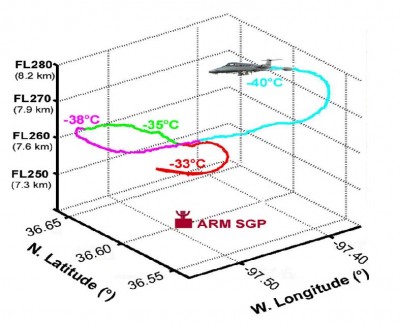SPARTICUS Flight Operations Extended Through June
Published: 15 May 2010
Planned research flights supporting the Small Particles in Cirrus (SPARTICUS) field campaign were scheduled to conclude at the end of April, but will now last through June. The science and operations team decided to extend the campaign for at least two more months based on the amount of remaining flight hours. This reserve was due to suboptimal conditions throughout February, when low clouds and winter storm systems persisted over the Southern Great Plains (SGP) area, preventing the desired cirrus measurements. The campaign extension will ensure a complete data set for addressing the campaign’s scientific questions.

In presenting a campaign update at the Atmospheric System Research Science Team Meeting in mid-March, SPARTICUS team members discussed the status of flight hours, preliminary data, and instrument performance since the campaign began in January. During the first 85 flight hours, nine flights focused on comparisons over the SGP site, with ascending and descending spirals over the Central Facility plus long horizontal legs at several altitudes. Another nine flights corresponded with A-train satellite overpasses, with the aircraft completing the horizontal legs and spirals along the satellite track, sampling cirrus as much as possible throughout the flight domain.
Overall, the instruments deployed during SPARTICUS have performed well thus far, except for measurements of total water concentration, particularly for thin clouds with small water contents. In June, researchers will use a different probe during SPARTICUS flights that is anticipated to provide important constraints on the condensed mass derived from the ice crystal concentration probes. Contrary to results from several previous aircraft campaigns in cirrus, measurements obtained with improved optical probes show much lower concentrations of small (sub-50 micron) ice crystals except for regions near cloud top, where small crystal concentrations are found at times to exceed 1 per cubic centimeter.
Data from these flights will assist scientists in determining the contribution of small particles to the overall concentration of ice particles in mid-latitude cirrus clouds. The data will also aid in the development of ground-based remote-sensing retrieval algorithms that help characterize cloud properties needed for the evaluation and improvement of climate models.
The ARM Climate Research Facility is a DOE Office of Science user facility. The ARM Facility is operated by nine DOE national laboratories, including .
Keep up with the Atmospheric Observer
Updates on ARM news, events, and opportunities delivered to your inbox
ARM User Profile
ARM welcomes users from all institutions and nations. A free ARM user account is needed to access ARM data.


















